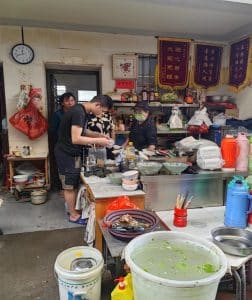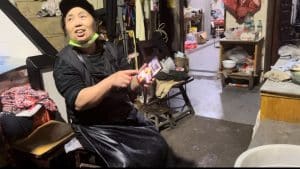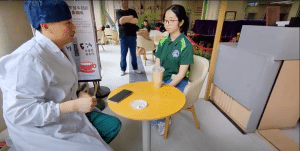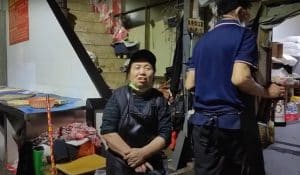
Figure1: Peng, Z. (2024). Photographs of the Charity Kitchen [Photograph].
The notion of a Charity Kitchen may be unfamiliar to people outside China. These kitchens are often seen around cancer hospitals and offer utensils and sometimes basic ingredients, with a relatively low fee for cooking. The oldest one was established in Nanchang City, Jiangxi Province, in 1992 by a couple, Wan Zuocheng and Xiong Gengxiang.
Xiong and Wan never take a day off to keep the Charity Kitchen functioning smoothly. When asked about their daily schedule, Xiong, who is always talkative, told me that they “usually get up at 4 am to prepare breakfast for users. Closing time depends on when the last user leaves.” In 2020, they were awarded the Moving China Medal for their great deeds, yet they were unwilling to travel to Beijing to attend the award ceremony, fearing that the kitchen might face issues without their care. The couple “saw themselves as the parents of a family, constituted of patients and their caregivers” (Xiong Gengxiang and Wan Zuocheng, personal communication, April 28). By caring for them tirelessly like parents, they felt fulfilled. Despite the shabby surroundings, the couple manages to keep the kitchen clean. Wan was wiping the containers for condiments over and over while his wife was being interviewed. The ovens were also carefully cleaned. Though these details might seem inconsequential, they reflect the couple’s dedication and meticulousness more than words ever could.

Figure 2: Peng, Z. (2024). Photographs of the Charity Kitchen [Photograph].
There is a moving story behind the founding of the Charity Kitchen. In 1992, when the couple was still selling deep-fried dough sticks near Jiangxi Cancer Hospital, a mother with her pale-looking boy asked Wan Zuocheng if she could use his oven to cook. She explained that her son had bone cancer and missed his mother’s cooking badly. Compassion drove Wan to help her. Thereafter, an increasing number of patients and their caregivers turned to Wan for his oven to cook. Wan and Xiong, showing great kindness towards them, started the Charity Kitchen, where anyone who wished to cook could use the oven for free.

Figure 3: Peng, Z. (2024). Photographs of the Charity Kitchen [Photograph].
Cookware and basic condiments were always supplied for free. “We even shut down the deep-fried dough sticks stall, which used to earn us thousands of yuan a day,” said Xiong Gengxiang (personal communication, April 28). Initially, their act of charity was welcomed, but after some time, fewer users came because they felt embarrassed to use the kitchen for free. Therefore, the owners began to charge 0.5 yuan per dish. After 2016, they raised the price to 1 yuan, and it has remained unchanged since then.
This minimal fee is necessary due to the high cost of treatment. According to the “China Health Statistics Yearbook 2020,” the per capita medical expenses for inpatients in public hospitals in 2019 were 10,484.3 yuan, and the average medical expenses for inpatients with lung malignant tumors, gastric malignant tumors, acute leukemia, and other diseases exceeded 20,000 yuan. Therefore, reducing food expenses is essential. One solution is cooking meals instead of purchasing them, which can incur additional costs. Hence, the owners of the Charity Kitchen set a low price for cooking. This also explains why so many inpatients’ families are drawn to this model.

Figure 4: Peng, Z. (2024). Photographs of the Charity Kitchen [Photograph].
I also spoke to some users at the Charity Kitchen. From our conversations, I learned that they were mostly first-time users who came to the kitchen to prepare meals for their inpatient family members. They believed that homemade food was better for patients. One female participant mentioned that her husband missed her cooking, and another said that her father’s stomach distress could be relieved by cooked apples (Users of the Charity Kitchen, personal communication, April 29).
Cancer patients’ diets are not customized in most hospitals. Food provided by hospital canteens sometimes may not meet the personalized needs of some patients, as it is universally seasoned and cooked, usually with very few condiments. For example, patients with stomach cancer might struggle with digestion and may prefer fresh fruit with a certain degree of sourness to stimulate their appetite. One female participant mentioned that her father’s stomach distress could be relieved by cooked apples. A reduction in nutrient intake can weaken the immune system and lead to poor resistance against disease. An inadequate diet also causes mental distress. Eating is one of the basic sources of human pleasure, and the deprivation of this joy can increase negative feelings such as passiveness and depression, which can hinder recovery progress. Therefore, a customized diet is important for overall immunity and recovery from cancer. As patients’ families seek to improve their diet quality by providing customized meals, the emergence of the Charity Kitchen becomes essential.
The need for homemade food also has cultural significance. Chinese people often associate family with homemade food, which serves as a reminder of home and evokes a sense of nostalgia. However, most patients cannot be treated near their homes, as they often travel to areas with more advanced medical facilities to receive higher-quality treatment (Wang Jianbing, personal communication, April 29). This is largely due to the uneven distribution of medical resources in China.
I interviewed Dr. Wang Jianbing, a doctor at Jiangxi Cancer Hospital, who provided professional insights. Dr. Wang mentioned that some patients are transferred to Jiangxi Cancer Hospital from other cities (Wang Jianbing, personal communication, April 29). The interviewees were also mostly non-local people. Being away from home during the distress of illness, patients naturally seek mental solace and a sense of belonging, desiring connections with home. Therefore, the need for a kitchen where homemade food can be cooked arises.

Figure 5: Peng, Z. (2024). Photographs of the Charity Kitchen [Photograph].
Xiong stated, “Years of hard work did not crush our health but instead strengthened it” (Xiong Gengxiang and Wan Zuocheng, personal communication, April 28). Although they were optimistic about the future of the Charity Kitchen, they acknowledged that they could not run it forever. Dr. Wang pointed out, “The problem with the Charity Kitchen is that the owners will find it hard to sustain its operation for a long time” (Wang Jianbing, personal communication, April 29), given their age (Wan was born in 1954 and Xiong in 1956). Few people possess the same kindness and stoic determination as Wan and Xiong.
Their children are also unwilling to take over the Charity Kitchen, as Wan and Xiong have worked tirelessly from dawn to dusk for years without taking a single day off, fearing that the Kitchen could not function smoothly without their care. Once, Wan asked a volunteer who helped at the Charity Kitchen if he would take over after they retired. The volunteer felt trapped: he wanted to help the patients and the old couple as much as he could, but he could not commit the rest of his life to the Charity Kitchen. Running it requires a huge investment of time and effort without breaks. He had to decline Wan’s request, albeit regretfully.
As a result, many are concerned about the future of the Charity Kitchen, knowing that the owners can only run it for a limited number of years.

Figure 6: Peng, Z. (2024). Photographs of the Charity Kitchen [Photograph].
Furthermore, some users have accused the owner of having a bad temper. We also investigated the Charity Kitchen run by the hospital. A female participant who had previously cooked in the privately operated Charity Kitchen launched into a lengthy critique, stating, “The owner and their son are too strict. Sometimes they charge 1 yuan more than they should. In contrast, the hospital’s Charity Kitchen does not overcharge and operates without interference from the owners” (Personal communication with a female user of the hospital’s Charity Kitchen, April 30). Her portrayal of the owners sharply contrasts with the positive image presented in propaganda, which initially surprised me. I confirmed her statements multiple times, and she further expressed dissatisfaction, attributing her switch to using the hospital-run kitchen largely to the owners’ ill-temper. While not universally alleged, Xiong also acknowledged being somewhat “parental” (Personal communication with Xiong Gengxiang, April 29), indicating she often directs and occasionally orders users. Her enthusiasm might be perceived by some as overbearing. Therefore, bias against them could be a potential issue.
The results exceeded expectations, as Xiong and Wan were criticized by their users. However, I must acknowledge the bias of propaganda, which tends to highlight a person’s positive attributes while often overlooking their shortcomings, which every person possesses. Furthermore, individuals’ personalities can be interpreted differently by others, and actions do not always reflect intentions perfectly. This does not necessarily mean that Xiong and Wan are predominantly negative; rather, their actions may be perceived as overbearing, despite their original intention to help patients. Overall, whether they are short-tempered is open to interpretation, but one thing is certain: their primary goal is to assist patients, even if it is not always explicitly demonstrated through their actions.

Figure 7: Peng, Z. (2024). Photographs of the Charity Kitchen [Photograph].
Given the array of potential issues, one promising approach, inspired by Jiangxi Cancer Hospital, could be the establishment of hospital-run Charity Kitchens. With the hospital’s ongoing support, these kitchens would never face financial insolvency. Owners need not worry about sustainability, as these kitchens are not only founded on goodwill but also on solid financial backing and credibility.
Dr. Wang also emphasized the importance of competition in the development of Charity Kitchens (Personal communication with Wang Jianbing, April 29). He suggested that “Charity Kitchens can be viewed as spontaneous market endeavors, making them a form of charitable business. Introducing competition, such as the proliferation of other Charity Kitchens, can prevent monopolies and encourage each kitchen to improve its services” (Personal communication with Wang Jianbing, April 29).
With strong support from the local government, Wan and Xiong could potentially sustain their kitchen for the long term.



